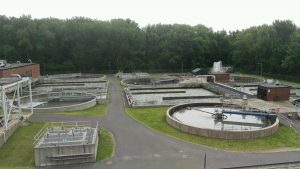WESTFIELD—Another change may be coming to the Westfield’s water standards—this time in wastewater—and officials are trying to stay ahead of it before it becomes a problem.
The Environmental Protection Agency (EPA) may be putting a nitrogen limit on wastewater plants that discharge into the Connecticut River and eventually run to Long Island Sound, which is suffering from low-oxygen conditions, according to Jeff Gamelli, Westfield’s deputy superintendent of wastewater.
If this happens, depending on how far the limit drops, Westfield and other communities could be funding millions of dollars for upgrades, or otherwise devising unique solutions within their wastewater treatment, according to Gamelli.
“They’ve been working from Long Island Sound up. Connecticut is already on board,” Gamelli said.
“Connecticut’s been successful. We’re trying to mirror them and get a preliminary jump on it,” he added.
Gamelli said that what may occur is a total nitrogen limit, which Westfield’s wastewater—or water resource recovery, as Gamelli calls it—does not currently have. The limit would work by reducing the amount of allowable “total nitrogen effluent limit” that the wastewater plants can offload into water.
Gamelli said that there have been no numbers that have been settled on nor definitive timetable, but some numbers have been tentatively discussed.
“We don’t know what the limit will be but we believe there will be one,” he said. “There will be more information in December from the EPA.”
The limit is due to an issue with hypoxic, or low-oxygen, conditions that are occurring on Long Island Sound, with high nitrogen levels being a cause, Gamelli said.
From the EPA website, too much nitrogen and phosphorus can create an environment where algae grows faster than the ecosystem can handle.
“Significant increases in algae harm water quality, food resources and habitats, and decrease the oxygen that fish and other aquatic life need to survive,” according to the webpage EPA “Nutrient Pollution.”
In addition, this can also be harmful to humans, per the page.
To solve, treatment plants can opt to upgrade their facilities, which Gamelli said Chicopee was given an estimated cost of $80 million to $115 million for this option. Also worth noting: According to Gamelli, in 2014 Chicopee’s nitrogen level in wastewater was 9 mg/L; Westfield’s was 10 mg/L.
This is not the only option for municipalities, though. They can also figure out within their own plants what they can do to modify and meet limits—which is what Gamelli has been working on—or work on a nitrogen trading program with other communities, which is also being discussed.
One solution that Gamelli is looking at in Westfield is to figure out how to break down the nitrogen based on the facility available.
Currently, the plant turns ammonia nitrogen, which is a byproduct of human waste, into nitrate through a biological process. From there, the nitrate is turned into nitrogen, which is then displaced.
A second half to this process would have to be figured out, which could be where cost and changes occur.
“We would have to change the process to denitrification,” he said. “To achieve the second step it’s challenging if you have limited area. Basically, you need to expand the size of your biological treatment system.”
And in Westfield, this would also come with a unique set of additional circumstances at the wastewater treatment facility.
“What’s different in Westfield is we have a total phosphorus limit,” Gamelli said. “That’s been our number one crux in the process.”
According to Gamelli, the bacteria that are used to treat nitrogen and the bacteria used for phosphorus compete for food with one another. And while some contaminants of wastewater can be treated chemically, such as e. coli, Gamelli said that’s not the case for nitrogen. Instead, he said, it must be a biological solution.
“A lot of people think treatment is just going through a filter but it’s a sensitive balance,” he said.


